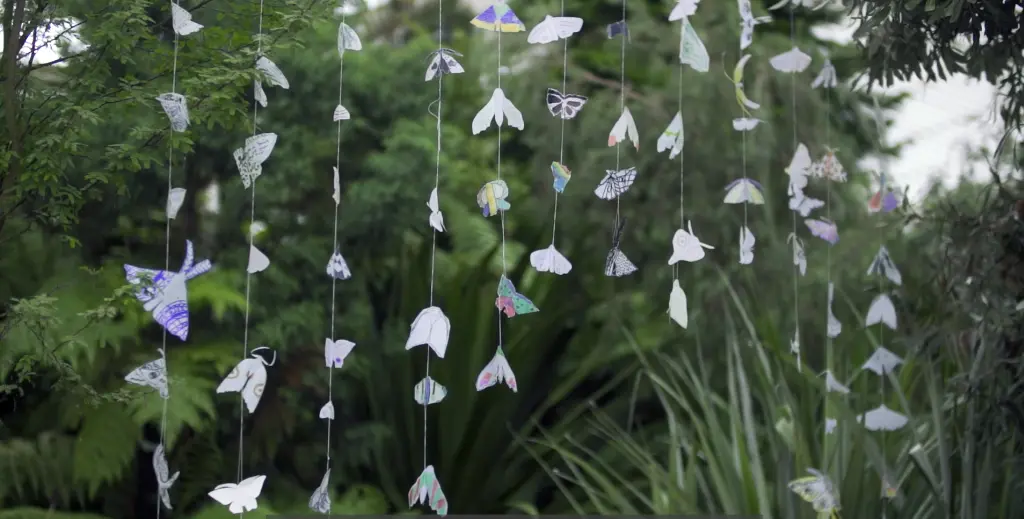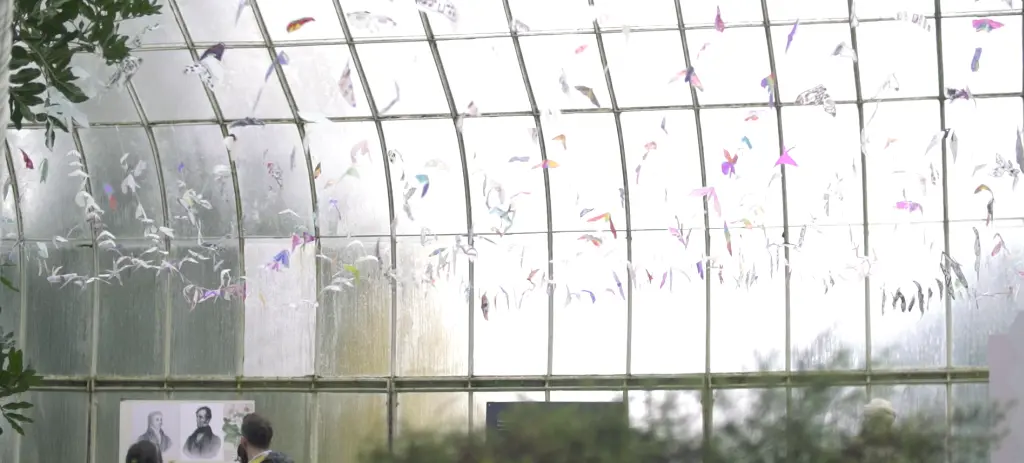DAY 7
On Sunday we headed for Woodlands Methodist Church for their service. It has been a hub of activities over the last week. The room was set out cafe style for worship and good quality free coffee was on offer (a promising start).

The sermon included a critique of the tendency of activists to be hypocritical and blame everyone but themselves for the climate crisis (salutary!) It was followed by Communion with a freshly baked loaf of bread. The communion cup was the one used by John Wesley way back at the beginning of the Methodist movement. It felt like a special occasion, like getting out the best tea set at Christmas. The minister kneeled as he gave everyone the bread, a moving and astonishing gesture. Afterwards we were offered a free sandwich lunch and the chance to meet young activists from around the world working for “Climate Justice for all”. They are building awareness of climate change in their own countries. This is Irene Osei Abra from Ghana.

A modern icon painter, Basia Mindewitcz, https://basiamindewicz.weebly.com/ had set up her studio in the churches old library. I liked her work.

Afterwards Peter went off to the Glasgow Bangladesh Association, where he showed his slides to his biggest audience of the week (around 30 people).
I went to the Botanical gardens to see the exhibition “Moths to a flame”. It is a project to engage people in conversations about community energy whilst encouraging them to make a moth to add to the thousands and thousands of moths made of tracing paper which had been hung all over the glasshouses. https://www.playscotland.org/moths-to-a-flame-installation-at-glasgows-botanic-gardens/

To get to our destinations we both took the beautiful riverside walk along the Kelvin.

My last visit of the day was to the Quaker meeting house to see the panels of the Loving Earth project. https://lovingearth-project.uk/
Hundreds of these beautiful embroidered panels have been made for COP, each one telling a story.


On the way there I passed the CCA (Centre for Contemporary Arts) which also had an exhibition of textiles, this time of trees, made by people in the Amazon, and a window with pictures of the 611 climate activists who were murdered last year. Truly sad and shocking.
Day 8
Today was our final day, and a day off from volunteering, so we had booked for several events in the Green Zone. The first of them was a very powerful session on the need to respect the knowledge of indigenous peoples as a way for the rest of us to get to sustainability, as they have lived in reciprocity with the rest of nature for many generations. One of the speakers, an indigenous young woman from Alaska (her anglicised name was Ruth Miller) https://unfoundation.org/blog/post/protectors-of-progress-ruth-stands-up-for-climate-justice/) spoke powerfully of the wisdom and knowledge of her people in their relationship with the natural world. She described how their rivers have been home to most of the world’s Salmon from time out of mind, and the fish had formed the staple diet of the people, but that last year there were almost no Salmon, the water is now too warm for the fish to live. She described how the permafrost is melting, releasing methane, how oil exploration is destroying Alaska and how, at COP, the indigenous voices have been excluded from the table. It was a passionatke and moving speech.

Afterwards we remembered the indigenous people we know in Bangladesh, both Garo and Santali, and the struggles they too have had from settlers taking away the land they work and the illegal logging from the forest when they have traditionally foraged for food.
The second session was a film on the Great Green Wall of Africa. https://www.greatgreenwall.org/about-great-green-wall
The aim is to create massive corridor of trees stretching right across from West to East Africa beneath the Sahel desert to prevent further desertification. This vast area has become even drier as a result of climate change so that people can no longer farm there. The film describes the agonies of huge numbers of young people who have no option but to set out on the dangerous migration route to Europe because their land yields no more. It also tells of the conflicts being created by the instability there.
The Great Green Wall was initiated by the UN in 2008 but has only achieved 15% of the ambition, I suspect because it was not based on the leadership and ownership of local people.
Peter then left to attend a workshop run by Alistair Macintosh at the Quaker Meeting House about how to hold a “Meeting for Clearness” a Quaker process to help discern the right way to go when making difficult decisions, thinking especially of post COP decisions. https://www.quaker.org.uk/documents/clearness-meeting-guidance-2012.pdf
Meanwhile, I sat eating my sandwiches and another of the coincidences of this COP happened. I got talking to a woman sitting next to me. She had been part of the Scottish Parliaments People’s Assembly over the last year, and that it had changed her whole way of thinking. It then turned out that her partner was actually attending the same workshop as Peter this afternoon!
The last film of the day was on how science is able to carefully evidence climate change. We had been invited to look through two different lens during the day, one which was about listening to the lived knowledge and experience of people “on the ground” and the other about the value of carefully evidenced science, which is the kind of wisdom the West listens to.
Afterwards I took a look around the stands. To me they were very disappointing, as many were focused on technological fixes, or corporate sponsors claiming to be green. There were few NGO’s or activists represented. It was a sad reflection of our government’s approach to the climate emergency, and how lacking it is in imagining a vision for a better future, let alone a vision for climate justice.
Our last event was a Christian Aid service at Glasgow Cathedral in the evening with Rowan Williams speaking.

Today we are off to visit friends in Castle Douglas and our COP will sadly be over. We have been deeply moved by the huge efforts of so many (and especially from the faith communities) over many months, to make this a “kairos” time, when new ways of seeing and acting can open up. That, in itself, has been a massive achievement.
We have been very grateful for the generous hospitality of Chris, our host, who has opened her home to us and with whom we enjoyed some great conversations!
But there is still all to play at COP. We’ll continue to “hold in the light” (as the Quakers would say) all those who are charged with making decisions about earths destiny at the conference in the next few days and beyond.


Moths to a Flame installation at Glasgow’s Botanic Gardens: Moths to a Flame will be open to the public daily for FREE throughout COP26 at Glasgow’s stunning Botanic Gardens. This mass participation art installation started in Plymouth, but has brought together moths and voices from all over the world to create a magnificent display of hope and community as we call for action on climate change at this important moment in the history of humanity.
Source
Image Source
Tags: Ruth Musgrave Days 7 and 8 at COP26


